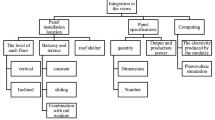Abstract
The energy efficiency of buildings plays a significant role in the development of distributed power generation in the city. The complex of energy-saving measures to improve the energy efficiency of buildings includes the development of structures and engineering systems using renewable energy sources, such as combined photovoltaic-thermal modules (PVT modules), which unite photovoltaic modules and solar collectors in one design. The use of PVT technology makes it possible to increase the electrical performance of solar cells due to their cooling during operation. The purpose of the article is to assess the energy characteristics of the PVT module in the course of experimental studies. A solar PVT module has been developed, containing a protective glass coating and connected solar cells placed between the glass and the casing with a coolant channel of a rectangular cross section. A system has been developed for automatic recording of the main parameters of the PVT module during field studies, which allows the energy characteristics of the module (including current–voltage characteristics) to be recorded with the required frequency, followed by storing the data array in a convenient form for further processing. The article presents a series of current–voltage characteristics measured during field studies and power curves of a PVT module for various values of total insolation and the specific coolant flow rate. At a specific coolant flow rate varying from 18 to 165 L/(h m2) and a total insolation of 880 W/m2, the specific thermal power of the module varies from 452.78 to 518.41 W/m2, and the specific electric power varies from 70 to 87 W/m2. The developed design of the PVT module allows an increase in the electrical performance by 10–20% compared with conventional photoelectric modules. The proposed design of the PVT module installed on the roofs and facades of buildings can solve the problem of the lack of space for solar energy facilities in urban areas and provide heat and electricity to consumers in the residential and public sectors.





Similar content being viewed by others
REFERENCES
Hasan, M.A. and Sumathy, K., Photovoltaic thermal module concepts and their performance analysis: A review, Renewable Sustainable Energy Rev., 2010, vol. 14, pp. 1845–1859.
Zondag, H.A., Bakker, M., and Helden, W.G.J., PVT Roadmap—a European guide for the development and market introduction of PV-Thermal technology, 2005. www.pvtforum.org. Accessed October 12, 2018.
Chow, T.T., A review on photovoltaic/thermal hybrid solar technology, Appl. Energy, 2010, vol. 87, pp. 365–379.
Radziemska, E., Performance analysis of a photovoltaic-thermal integrated system, Int. J. Photoenergy, vol. 2009, id. 732093. https://doi.org/10.1155/2009/732093
Kalogirou, S.A. and Tripanagnostopoulos, Y., Hybrid PV/T solar systems for domestic hot water and electricity production, Energy Convers. Manage., 2006, vol. 47, pp. 3368–3382.
Ibrahim, A., Li Jin, G., Daghigh, R., et al., Hybrid photovoltaic thermal (PV/T) air and water based solar collectors suitable for building integrated applications, Am. J. Environ. Sci., 2009, vol. 5, no. 5, pp. 618–624.
Xingxing, Zh., Xudong, Zh., Stefan, S., et al., Review of R&D progress and practical application of the solar photovoltaic/thermal (PV/T) technologies, Renewable Sustainable Energy Rev., 2012, vol. 16, pp. 599–617.
Zondag, H.A., Flat-plate PV-Thermal collectors and systems: A review, Renewable Sustainable Energy Rev., 2008, vol. 12, pp. 891–959.
Mayorov, V.A., Research on the thermal characteristics of a thermal photovoltaic solar module with a concentrator and a detector with a triangular profile, Appl. Sol. Energy, 2019, vol. 55, no. 1, pp. 57–65.
Ibrahim, A., Othman, M.Y., Ruslan, M.H., et al., Recent advances in flat plate photovoltaic/thermal (PV/T) solar collectors, Renewable Sustainable Energy Rev., 2011, vol. 15, pp. 352–365.
Dube, S. and Tay, A.O., Experimental study of the performance of two different types of photovoltaic thermal (PVT) modules under Singapore climatic conditions, Ashdin Publ. J. Renewable Energy Appl., 2012, vol. 2, id. R120313. https://doi.org/10.4303/jfrea/R120313
Vakiv, N.M., Krukovskii, S.I., Nikolaenko, Yu.E., et al., Solar cell module based on A3B5 compounds with solar concentrators and heat removal system, Tekhnol. Konstr. Elektron. Appar., 2010, no. 2, pp. 10–13.
Khairnasov, S., Rassamakin, B., Musiy, R., and Rassamakin, A., Solar collectors of buildings facade based on aluminum heat pipes with colored coating, J. Civ. Eng. Archit., 2013, vol. 7, no. 4, pp. 403–409.
Rassamakin, B., Khairnasov, S., Zapirov, V., et al., Aluminum heat pipes applied in solar collectors, Sol. Energy, 2013, no. 94, pp. 145–154.
Tikhonov, P.V., Justification of the parameters of the photovoltaic thermal module, Cand. Sci. (Eng.) Dissertation, Moscow, All-Russian Scientific Research Institute of Agricultural Electrification, 2014.
Tiwari, A. and Sodha, M.S., Performance evaluation of hybrid PV/thermal water/air heating system: a parametric study, Renewable Energy, 2006, vol. 31, pp. 2460–2474.
Rosell, J.I., Vallverdu, X., Lechon, M.A., and Ibanez, M., Design and simulation of a low concentrating photovoltaic/thermal system, Energy Convers. Manage., 2005, vol. 46, pp. 3034–3046.
Fontenault, B.J. and Gutierrez-Miravete, E., Modeling a combined photovoltaic-thermal solar panel, Excerpt from the Proceedings of the 2012 COMSOL Conference in Boston, 2012.
Strebkov, D.S., Irodionov, A.E., Persits, I.S., and Filippchenkova, N.S., RF Patent 2546332, 2015.
Panchenko, V.A., Strebkov, D.S., and Persits, I.S., Solar modules with extended rated work, Al’tern. Energ. Ekol., 2015, vol. 19, no. 183, pp. 55–60.
Strebkov, D.S. and Bezrukikh, P.P., Vozobnovlyaemaya energetika: strategiya, resursy, tekhnologii (Renewable Energy: Strategy, Resources, Technologies), Moscow: Vseross. Inst. Elektrif. Sel. Khoz., 2005.
Strebkov, D.S., Irodionov, A.E., and Filippchenkova, N.S., Solnechnye kontsentratornye moduli s zhalyuziinymi geliostatami (Solar Concentrator Modules with Louvered Heliostats), Moscow: Fed. Nauchn. Agroinzh. Tsentr VIM, 2019.
Funding
The study was funded by the Federal State Budgetary Institution “Fund for Assistance to Small Innovative Enterprises in Science and Technology” (Fund for Assistance to Innovation) according to contract no. 15711GU/2020 (dated July 11, 2020).
Author information
Authors and Affiliations
Corresponding author
Additional information
Translated by M. Chubarova
About this article
Cite this article
Strebkov, D.S., Filippchenkova, N.S. Results of an Experimental Study of a Solar Photovoltaic-Thermal Module. Appl. Sol. Energy 56, 442–448 (2020). https://doi.org/10.3103/S0003701X20060110
Received:
Revised:
Accepted:
Published:
Issue Date:
DOI: https://doi.org/10.3103/S0003701X20060110




